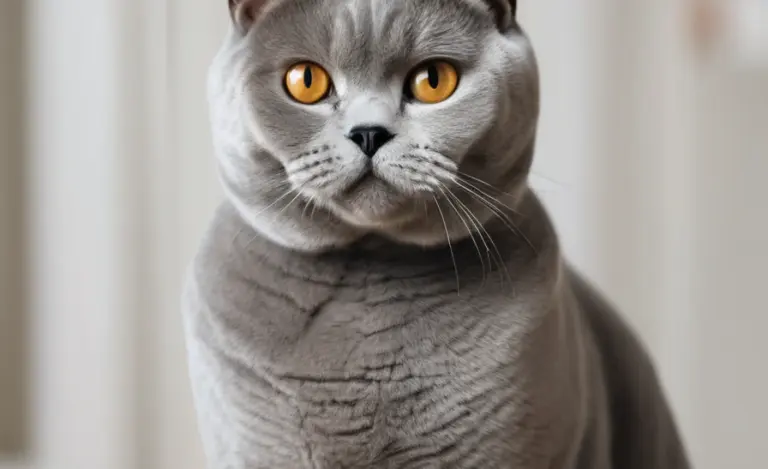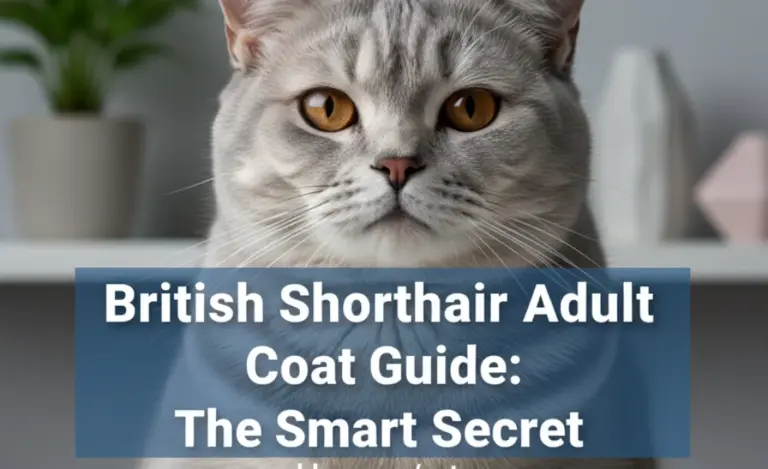British Shorthair Breed Size Guide: The Ultimate Guide
Have you ever seen a cat that looks like a fluffy teddy bear? That might be a British Shorthair! These cats are known for their round faces and thick fur. But how big do they really get? This article will be your British Shorthair breed size guide. We’ll explore everything about their size. Get ready to learn all about these cuddly cats!
They are one of the most popular breeds. People love them because they are friendly and calm. Finding out about their size is important. This helps you know what to expect. Knowing their size will help you care for them better. Let’s dive into the world of British Shorthairs!
These cats are not tiny kittens forever. They grow into medium to large-sized cats. Understanding their growth helps you prepare. Are you ready to learn more about their size? Keep reading to become a British Shorthair expert!
Key Takeaways
- The British Shorthair breed size guide shows they typically weigh 9-17 pounds.
- Males are usually larger than females in this breed.
- They reach their full size around 3-5 years old.
- Proper diet and exercise help them maintain a healthy weight.
- Regular vet checkups are important for monitoring their growth.
Understanding the British Shorthair Breed Size Guide
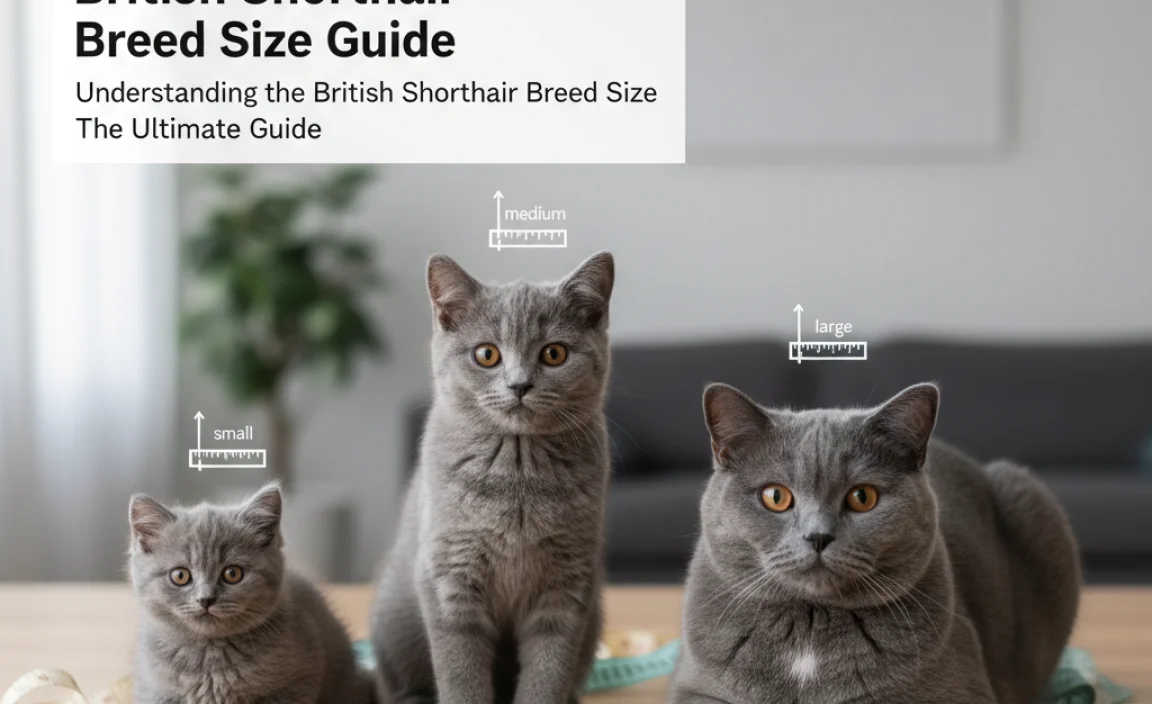
The British Shorthair is a medium to large-sized cat breed. It is important to understand their size to properly care for them. A typical adult male weighs between 9 and 17 pounds. Females are usually smaller, weighing between 7 and 12 pounds. Their body length can range from 20 to 25 inches. Height at the shoulder is usually around 12 to 14 inches. These measurements help you understand their overall size. Knowing their size helps you choose the right carrier. It also helps you provide the right amount of food.
- Males are generally larger than females.
- Their weight can vary based on diet and activity.
- Body length is measured from nose to tail base.
- Height is measured at the highest point of the shoulder.
- Regular vet visits help monitor their growth and size.
Understanding the British Shorthair breed size guide helps you be a better owner. It is not just about weight and height. It is also about understanding their body composition. British Shorthairs have a stocky, muscular build. This contributes to their overall size and weight. Knowing this helps you provide the right exercise. It also helps you manage their diet effectively. Keeping them healthy and happy is the goal. Understanding their size is a big part of that.
What is the Average Weight?
What is the ideal weight for a British Shorthair? The average weight for a male is 9-17 pounds. For females, it’s usually 7-12 pounds. But weight isn’t everything. Body condition is also very important. A healthy British Shorthair should have a well-proportioned body. You should be able to feel their ribs without too much pressure. If you can’t feel their ribs, they may be overweight. If their ribs are too prominent, they may be underweight. Regular vet visits can help you determine their ideal weight.
How Tall Do They Typically Grow?
How tall do British Shorthairs get? Their height at the shoulder is usually 12-14 inches. This measurement is important. It helps you choose the right size cat tree. It also helps you make sure they can easily reach their food and water bowls. Remember, height can vary slightly. Genetics and diet play a role. Providing a balanced diet is key. This helps them reach their full potential. A healthy cat is a happy cat.
How Long is Their Body?
Have you ever wondered how long a British Shorthair is? Their body length usually ranges from 20 to 25 inches. This is measured from their nose to the base of their tail. This length can influence the type of bed you buy. A longer cat needs a longer bed. Make sure they have enough space to stretch out. A comfortable cat is a happy cat. Keep their size in mind when choosing their accessories. This will ensure they have a comfortable life.
Fun Fact or Stat: The heaviest British Shorthair on record weighed over 30 pounds!
Growth Stages and the British Shorthair Breed Size Guide
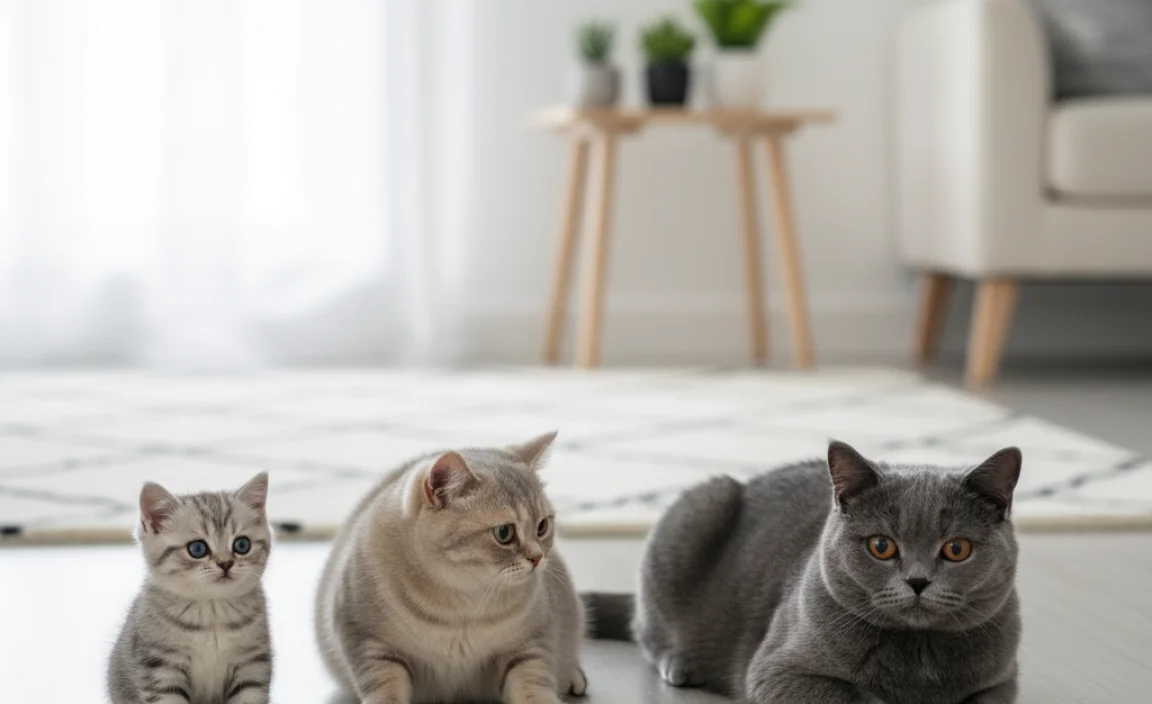
Understanding the growth stages of a British Shorthair is important. Kittens grow quickly in their first few months. They reach near-adult size by about one year. However, they continue to fill out and gain muscle. They reach their full maturity around 3-5 years old. Knowing these stages helps you adjust their diet. It also helps you adjust their exercise routine. British Shorthair breed size guide considers these growth stages. This ensures they develop properly.
- Kittens grow rapidly in the first six months.
- They reach near-adult size by one year.
- They continue to mature until 3-5 years old.
- Proper nutrition is crucial during growth stages.
- Regular vet checkups monitor their development.
- Adjust food portions as they grow.
During the kitten stage, they need a diet rich in protein. This supports their rapid growth. As they mature, adjust their diet. Ensure it supports their muscle development. Older cats may need fewer calories. This prevents them from becoming overweight. Monitoring their weight and body condition is important. This helps you ensure they stay healthy. Remember, every cat is different. Their growth may vary slightly. Consult with your vet for personalized advice.
Kitten Growth Milestones
What should you expect during the kitten stage? Newborn British Shorthair kittens are very small. They weigh only a few ounces. By 8 weeks, they start to look more like adult cats. They become more playful and active. At 6 months, they are almost full-sized. However, they still have some growing to do. Providing high-quality kitten food is essential. This supports their rapid growth. Regular playtime helps them develop their muscles.
Adolescent Growth
What happens during adolescence? This stage is between 6 months and 1 year. They are almost full-sized. But they are still maturing. Their personality becomes more defined. They may become more independent. Continue to provide a balanced diet. Make sure they get enough exercise. This helps them stay healthy and happy. Regular vet checkups are still important.
Adult Growth
When do they reach full adulthood? British Shorthairs typically reach full maturity at 3-5 years. This is when they reach their full size and muscle mass. Their personality is fully developed. They are usually calmer than kittens. They still need regular exercise and a balanced diet. Monitor their weight to prevent obesity. Regular vet visits are essential.
Fun Fact or Stat: British Shorthairs are one of the slowest-maturing cat breeds!
Factors Influencing British Shorthair Size

Several factors influence the British Shorthair breed size guide. Genetics play a big role. Some cats are naturally larger than others. Diet is also crucial. A balanced diet supports healthy growth. Exercise helps them maintain a healthy weight. Health conditions can also affect their size. Regular vet visits help identify and manage these conditions. Understanding these factors helps you provide the best care.
- Genetics play a significant role in size.
- Diet is crucial for healthy growth.
- Exercise helps maintain a healthy weight.
- Health conditions can affect their size.
- Regular vet visits are important.
- Environment can also influence their size.
Genetics determine their potential size. Diet provides the building blocks for growth. Exercise helps them build muscle. It also prevents obesity. Health conditions can stunt growth. Regular vet visits can catch these early. Environment also plays a role. A stressful environment can affect their appetite. This can impact their growth. Providing a safe and loving home is important. This helps them thrive.
The Role of Genetics
How much do genetics matter? Genetics determine their potential size and build. If their parents were large, they are likely to be large too. However, genetics are not the only factor. Diet and exercise also play a role. Even with good genetics, poor diet can stunt their growth. Providing a healthy environment is essential. This helps them reach their full potential.
The Importance of Diet
Why is diet so important? A balanced diet is essential for healthy growth. Kittens need a diet rich in protein. This supports their rapid development. Adult cats need a diet that maintains their muscle mass. Avoid overfeeding. This can lead to obesity. Choose high-quality cat food. This ensures they get all the nutrients they need.
The Impact of Exercise
How does exercise affect their size? Exercise helps them build muscle. It also helps them burn calories. This prevents them from becoming overweight. Provide plenty of toys and playtime. This encourages them to be active. A healthy cat is an active cat. Regular exercise keeps them in good shape. It also improves their overall well-being.
Fun Fact or Stat: British Shorthairs are prone to obesity if they don’t get enough exercise!
Comparing British Shorthair Size to Other Breeds

Compared to other breeds, where do British Shorthairs stand? They are considered medium to large-sized cats. They are larger than breeds like the Siamese. But smaller than breeds like the Maine Coon. Understanding these comparisons helps you appreciate their size. It also helps you choose the right breed for your lifestyle. The British Shorthair breed size guide helps you see how they fit.
| Breed | Average Weight (lbs) | Average Height (inches) |
|---|---|---|
| British Shorthair | 9-17 | 12-14 |
| Siamese | 8-12 | 8-10 |
| Maine Coon | 13-18 | 10-16 |
| Persian | 7-12 | 10-12 |
When comparing breeds, consider their overall build. British Shorthairs have a stocky, muscular build. This makes them appear larger than some breeds. Even if they weigh the same. Maine Coons are longer and taller. This gives them a different appearance. Siamese cats are slender and more petite. Choose a breed that fits your lifestyle. Consider their size and energy levels.
British Shorthair vs. Siamese
How do British Shorthairs compare to Siamese cats? Siamese cats are smaller and more slender. They typically weigh 8-12 pounds. British Shorthairs are larger and more muscular. They weigh 9-17 pounds. Siamese cats are also more active. British Shorthairs are known for being more laid-back. Consider your lifestyle when choosing a breed. If you want a small, active cat, choose a Siamese. If you want a larger, calmer cat, choose a British Shorthair.
British Shorthair vs. Maine Coon
How do British Shorthairs compare to Maine Coons? Maine Coons are one of the largest cat breeds. They can weigh up to 18 pounds or more. British Shorthairs are smaller. They typically weigh 9-17 pounds. Maine Coons also have longer bodies and tails. British Shorthairs are stockier and more compact. Maine Coons need more space. British Shorthairs can adapt to smaller living spaces.
British Shorthair vs. Persian
How do British Shorthairs compare to Persians? Persians are medium-sized cats. They typically weigh 7-12 pounds. British Shorthairs are slightly larger. They weigh 9-17 pounds. Persians are known for their long, fluffy fur. British Shorthairs have short, dense fur. Persians require more grooming. British Shorthairs are easier to groom. Choose a breed that fits your lifestyle and grooming preferences.
Fun Fact or Stat: Maine Coons are often called “gentle giants” because of their large size and friendly nature!
Maintaining a Healthy Size for Your British Shorthair
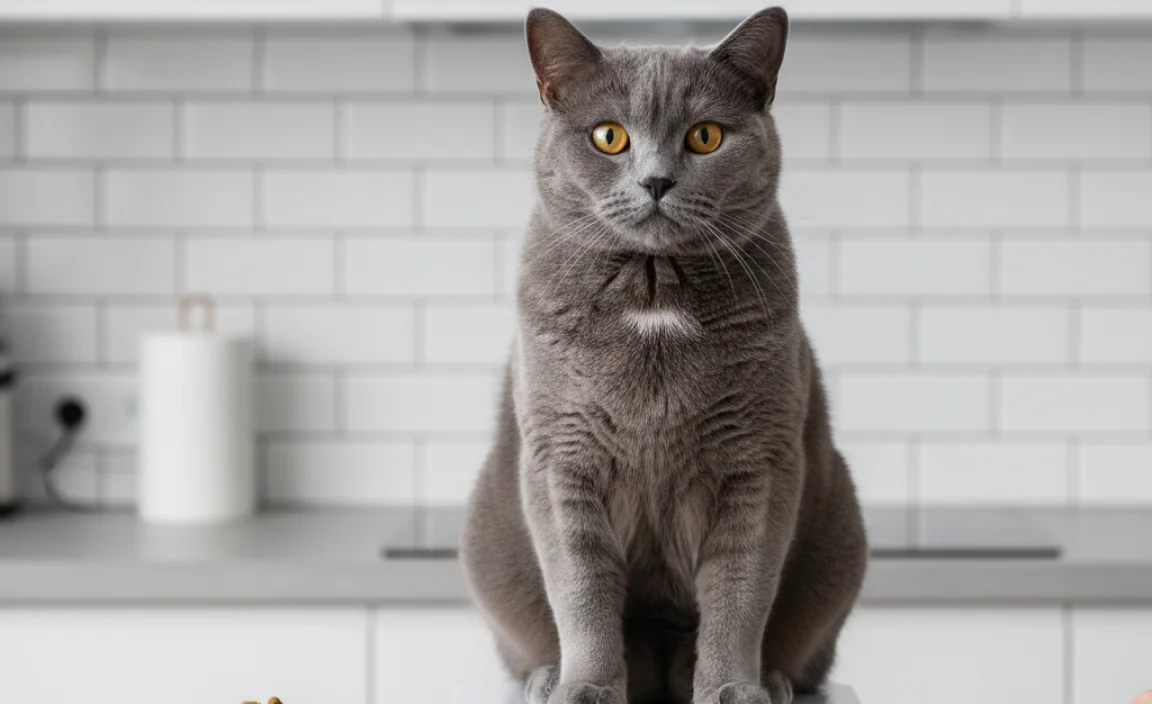
Maintaining a healthy size is important for your British Shorthair. Proper diet and exercise are key. Regular vet visits help monitor their weight. Avoid overfeeding. This can lead to obesity. Provide plenty of toys and playtime. This encourages them to be active. A healthy cat is a happy cat. The British Shorthair breed size guide highlights these points.
- Provide a balanced diet.
- Avoid overfeeding.
- Encourage regular exercise.
- Monitor their weight regularly.
- Schedule regular vet visits.
- Provide plenty of fresh water.
- Choose high-quality cat food.
A balanced diet provides the nutrients they need. Avoid giving them too many treats. This can lead to weight gain. Exercise helps them burn calories. It also helps them build muscle. Monitor their weight regularly. If you notice changes, consult your vet. Regular vet visits can catch health issues early. Early detection is key to maintaining their health.
Choosing the Right Food
What kind of food should you choose? Choose high-quality cat food. Look for food that is rich in protein. Avoid food with a lot of fillers. Read the ingredient list carefully. Make sure the food is appropriate for their age. Kittens need different food than adult cats. Senior cats need different food than younger cats. Consult your vet for recommendations.
Encouraging Exercise
How can you encourage exercise? Provide plenty of toys. Rotate the toys regularly. This keeps them interested. Play with them daily. Use a laser pointer or a feather wand. Create a stimulating environment. Provide cat trees and scratching posts. This encourages them to climb and explore. A tired cat is a happy cat.
Monitoring Weight and Body Condition
How can you monitor their weight? Weigh them regularly. Keep a record of their weight. Feel their ribs. You should be able to feel them without too much pressure. Look at their body shape. They should have a defined waist. If they look round, they may be overweight. Consult your vet if you have concerns.
Fun Fact or Stat: Playing with your cat for just 15 minutes a day can significantly improve their physical and mental health!
Potential Health Issues Related to Size
Certain health issues can be related to size in British Shorthairs. Obesity is a common problem. This can lead to diabetes and joint problems. Hypertrophic cardiomyopathy (HCM) is a heart condition. It is more common in larger cats. Polycystic kidney disease (PKD) is another concern. Regular vet visits can help detect these issues early. Understanding the British Shorthair breed size guide helps you be aware.
- Obesity can lead to diabetes.
- Joint problems are common in overweight cats.
- HCM is a heart condition seen in larger cats.
- PKD is a kidney disease.
- Regular vet visits are crucial for early detection.
- Proper diet and exercise can prevent obesity.
Obesity puts extra stress on their joints. This can lead to arthritis. Diabetes can cause serious health problems. HCM can lead to heart failure. PKD can damage their kidneys. Early detection and treatment are key. Maintain a healthy weight. This reduces the risk of these health issues. A healthy cat lives a longer, happier life.
Obesity and Its Risks
What are the risks of obesity? Obesity can lead to many health problems. These include diabetes, joint problems, and heart disease. It can also shorten their lifespan. Prevent obesity by providing a balanced diet. Encourage regular exercise. Avoid giving them too many treats. A healthy weight is essential for their well-being.
Hypertrophic Cardiomyopathy (HCM)
What is HCM? HCM is a heart condition. It causes the heart muscle to thicken. This makes it harder for the heart to pump blood. It can lead to heart failure. There is no cure for HCM. But it can be managed with medication. Regular vet checkups can help detect HCM early.
Polycystic Kidney Disease (PKD)
What is PKD? PKD is a kidney disease. It causes cysts to form on the kidneys. These cysts can damage the kidneys. This leads to kidney failure. There is no cure for PKD. But it can be managed with medication and diet. Genetic testing can help identify cats at risk.
Fun Fact or Stat: Over 50% of cats in the United States are overweight or obese!
Summary
The British Shorthair breed size guide helps you understand what to expect from these wonderful cats. They are medium to large-sized. Males typically weigh 9-17 pounds. Females weigh 7-12 pounds. Their growth stages are important. Kittens grow quickly. They reach full maturity at 3-5 years. Genetics, diet, and exercise all play a role in their size.
Maintaining a healthy weight is crucial. Proper diet and exercise are key. Regular vet visits help monitor their health. Obesity can lead to health problems. HCM and PKD are also concerns. By understanding these factors, you can provide the best care for your British Shorthair. You will ensure they live a long, happy, and healthy life.
Conclusion
Understanding the British Shorthair breed size guide is vital. It helps you provide the best care for your feline friend. Remember, these cats are medium to large. They need a balanced diet and regular exercise. Monitor their weight and visit the vet regularly. By doing so, you can ensure they live a long, happy, and healthy life. Enjoy your cuddly companion!
Frequently Asked Questions
Question No 1: How big do British Shorthairs usually get?
Answer: British Shorthairs are medium to large-sized cats. Males typically weigh between 9 and 17 pounds. Females usually weigh between 7 and 12 pounds. Their body length can range from 20 to 25 inches. Height at the shoulder is around 12 to 14 inches. This British Shorthair breed size guide offers a good idea of their full size. Keep in mind that individual cats can vary. Genetics and diet play a role in their final size.
Question No 2: When do British Shorthairs reach their full size?
Answer: British Shorthairs grow at a slower pace than many other breeds. They typically reach their near-adult size by one year old. However, they continue to mature and fill out until they are 3-5 years old. This is when they reach their full muscle mass and body weight. This slow maturation is important to remember. It means you need to adjust their diet and exercise as they grow. The British Shorthair breed size guide considers this slow growth.
Question No 3: What factors affect the size of a British Shorthair?
Answer: Several factors can affect the size of a British Shorthair. Genetics play a big role. Some cats are naturally larger than others. Diet is also crucial. A balanced diet supports healthy growth. Exercise helps them maintain a healthy weight. Health conditions can also affect their size. Regular vet visits help identify and manage these conditions. Environment can also influence their appetite and growth. The British Shorthair breed size guide considers all these influences.
Question No 4: How can I tell if my British Shorthair is overweight?
Answer: There are several ways to tell if your British Shorthair is overweight. You should be able to feel their ribs without too much pressure. If you can’t feel their ribs, they may be overweight. Look at their body shape. They should have a defined waist when viewed from above. If they look round, they may be overweight. Weigh them regularly. Compare their weight to the average for their breed. Consult your vet if you have concerns. The British Shorthair breed size guide can help you compare.
Question No 5: What are the health risks associated with being overweight?
Answer: Being overweight can lead to many health problems for British Shorthairs. These include diabetes, joint problems, and heart disease. Obesity puts extra stress on their joints. This can lead to arthritis. Diabetes can cause serious health problems. Heart disease can lead to heart failure. Maintaining a healthy weight is essential. This reduces the risk of these health issues. A healthy cat lives a longer, happier life. Understanding the British Shorthair breed size guide helps you monitor their health.
Question No 6: How can I help my British Shorthair maintain a healthy weight?
Answer: There are several things you can do to help your British Shorthair maintain a healthy weight. Provide a balanced diet. Choose high-quality cat food. Avoid overfeeding. Give them measured portions. Encourage regular exercise. Provide plenty of toys and playtime. Monitor their weight regularly. Schedule regular vet visits. The British Shorthair breed size guide emphasizes these points. A healthy lifestyle is key to their well-being.

